Analyzing Sustainable Business: ENGT5219 Assignment A Report
VerifiedAdded on 2022/08/17
|9
|1508
|13
Report
AI Summary
This report analyzes sustainable business practices, focusing on the triple bottom line, five capitals, natural capitalism, cradle to cradle, and the circular economy. It also examines the balanced scorecard as a performance management tool. The report uses Nestlé as a case study, evaluating its performance through the lens of the triple bottom line (people, profit, planet) and the balanced scorecard (financial, internal business, knowledge & innovation, and customer perspectives). It discusses Nestlé's commitment to social responsibility, environmental sustainability, and financial performance, supported by data on its financial metrics and initiatives. The report concludes by highlighting Nestlé's strengths and its long-term approach to sustainable business practices and provides relevant references.
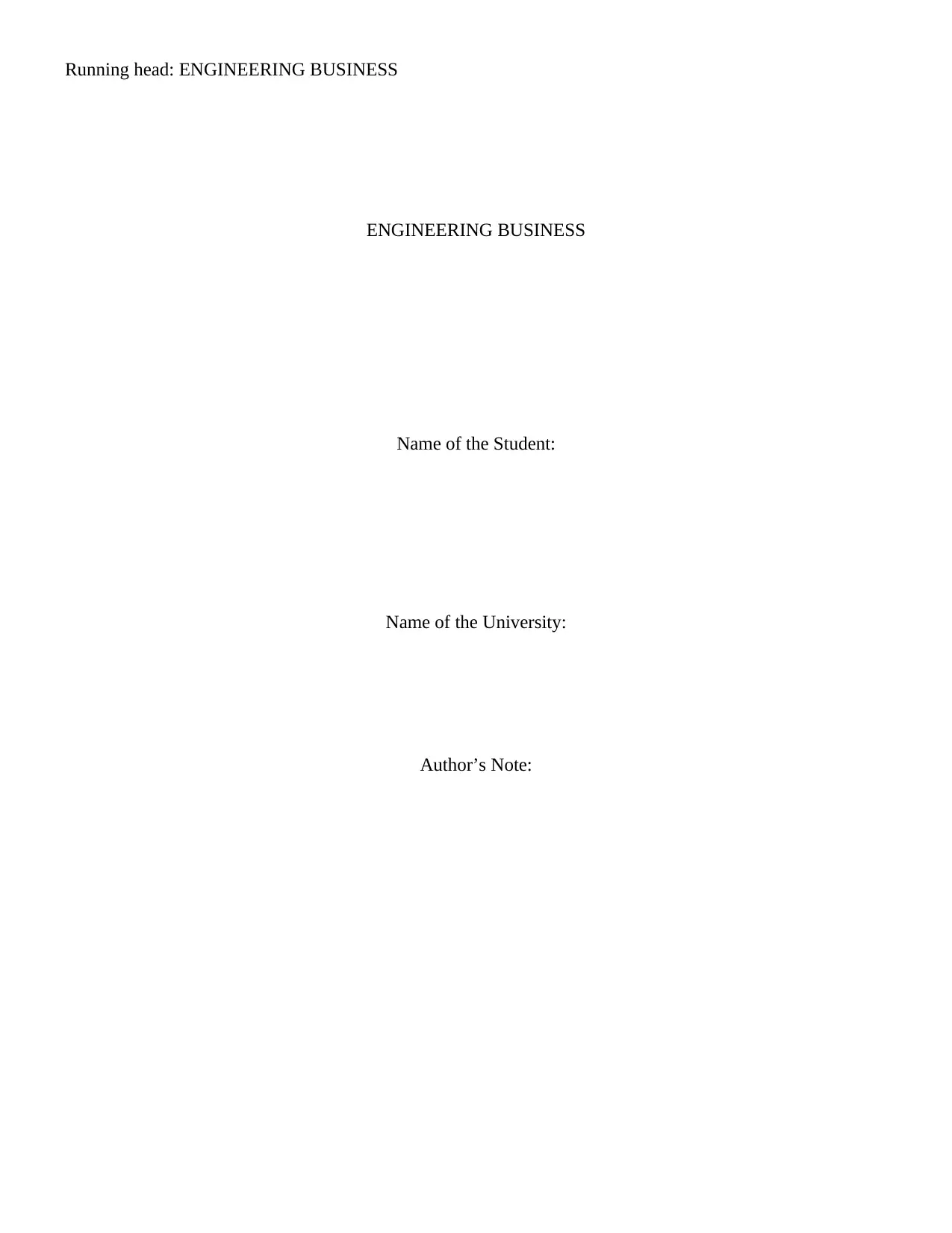
Running head: ENGINEERING BUSINESS
ENGINEERING BUSINESS
Name of the Student:
Name of the University:
Author’s Note:
ENGINEERING BUSINESS
Name of the Student:
Name of the University:
Author’s Note:
Paraphrase This Document
Need a fresh take? Get an instant paraphrase of this document with our AI Paraphraser
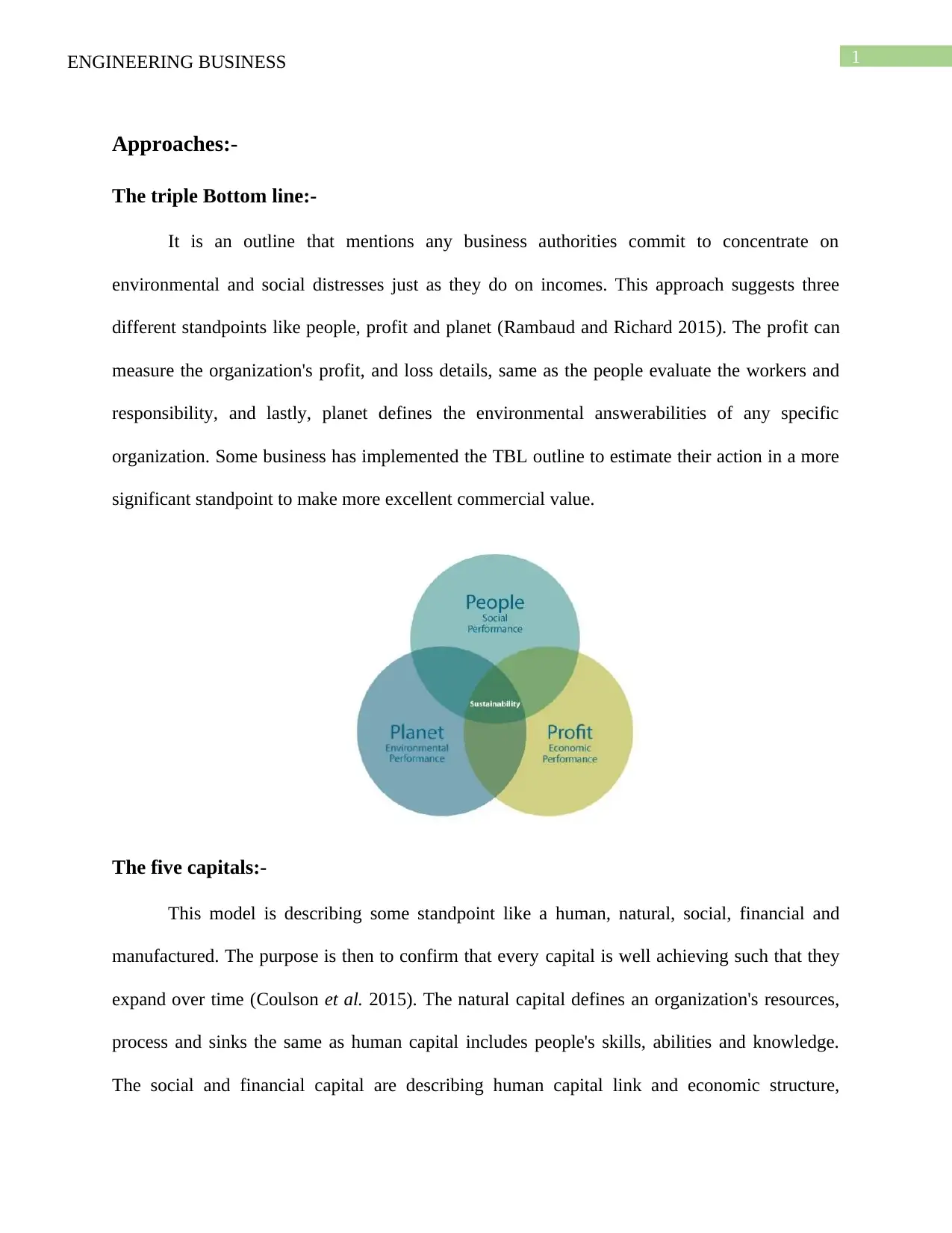
1ENGINEERING BUSINESS
Approaches:-
The triple Bottom line:-
It is an outline that mentions any business authorities commit to concentrate on
environmental and social distresses just as they do on incomes. This approach suggests three
different standpoints like people, profit and planet (Rambaud and Richard 2015). The profit can
measure the organization's profit, and loss details, same as the people evaluate the workers and
responsibility, and lastly, planet defines the environmental answerabilities of any specific
organization. Some business has implemented the TBL outline to estimate their action in a more
significant standpoint to make more excellent commercial value.
The five capitals:-
This model is describing some standpoint like a human, natural, social, financial and
manufactured. The purpose is then to confirm that every capital is well achieving such that they
expand over time (Coulson et al. 2015). The natural capital defines an organization's resources,
process and sinks the same as human capital includes people's skills, abilities and knowledge.
The social and financial capital are describing human capital link and economic structure,
Approaches:-
The triple Bottom line:-
It is an outline that mentions any business authorities commit to concentrate on
environmental and social distresses just as they do on incomes. This approach suggests three
different standpoints like people, profit and planet (Rambaud and Richard 2015). The profit can
measure the organization's profit, and loss details, same as the people evaluate the workers and
responsibility, and lastly, planet defines the environmental answerabilities of any specific
organization. Some business has implemented the TBL outline to estimate their action in a more
significant standpoint to make more excellent commercial value.
The five capitals:-
This model is describing some standpoint like a human, natural, social, financial and
manufactured. The purpose is then to confirm that every capital is well achieving such that they
expand over time (Coulson et al. 2015). The natural capital defines an organization's resources,
process and sinks the same as human capital includes people's skills, abilities and knowledge.
The social and financial capital are describing human capital link and economic structure,
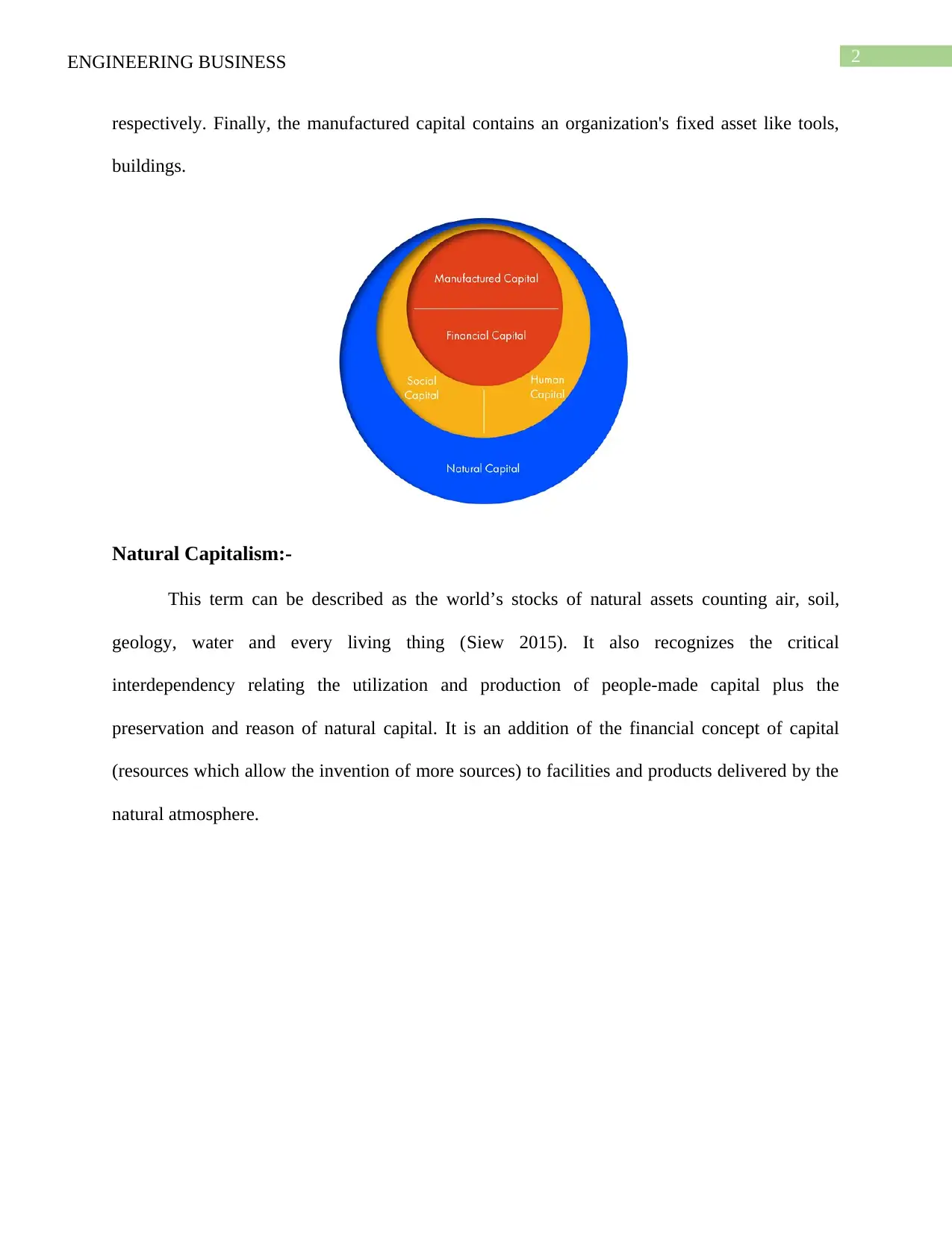
2ENGINEERING BUSINESS
respectively. Finally, the manufactured capital contains an organization's fixed asset like tools,
buildings.
Natural Capitalism:-
This term can be described as the world’s stocks of natural assets counting air, soil,
geology, water and every living thing (Siew 2015). It also recognizes the critical
interdependency relating the utilization and production of people-made capital plus the
preservation and reason of natural capital. It is an addition of the financial concept of capital
(resources which allow the invention of more sources) to facilities and products delivered by the
natural atmosphere.
respectively. Finally, the manufactured capital contains an organization's fixed asset like tools,
buildings.
Natural Capitalism:-
This term can be described as the world’s stocks of natural assets counting air, soil,
geology, water and every living thing (Siew 2015). It also recognizes the critical
interdependency relating the utilization and production of people-made capital plus the
preservation and reason of natural capital. It is an addition of the financial concept of capital
(resources which allow the invention of more sources) to facilities and products delivered by the
natural atmosphere.
⊘ This is a preview!⊘
Do you want full access?
Subscribe today to unlock all pages.

Trusted by 1+ million students worldwide
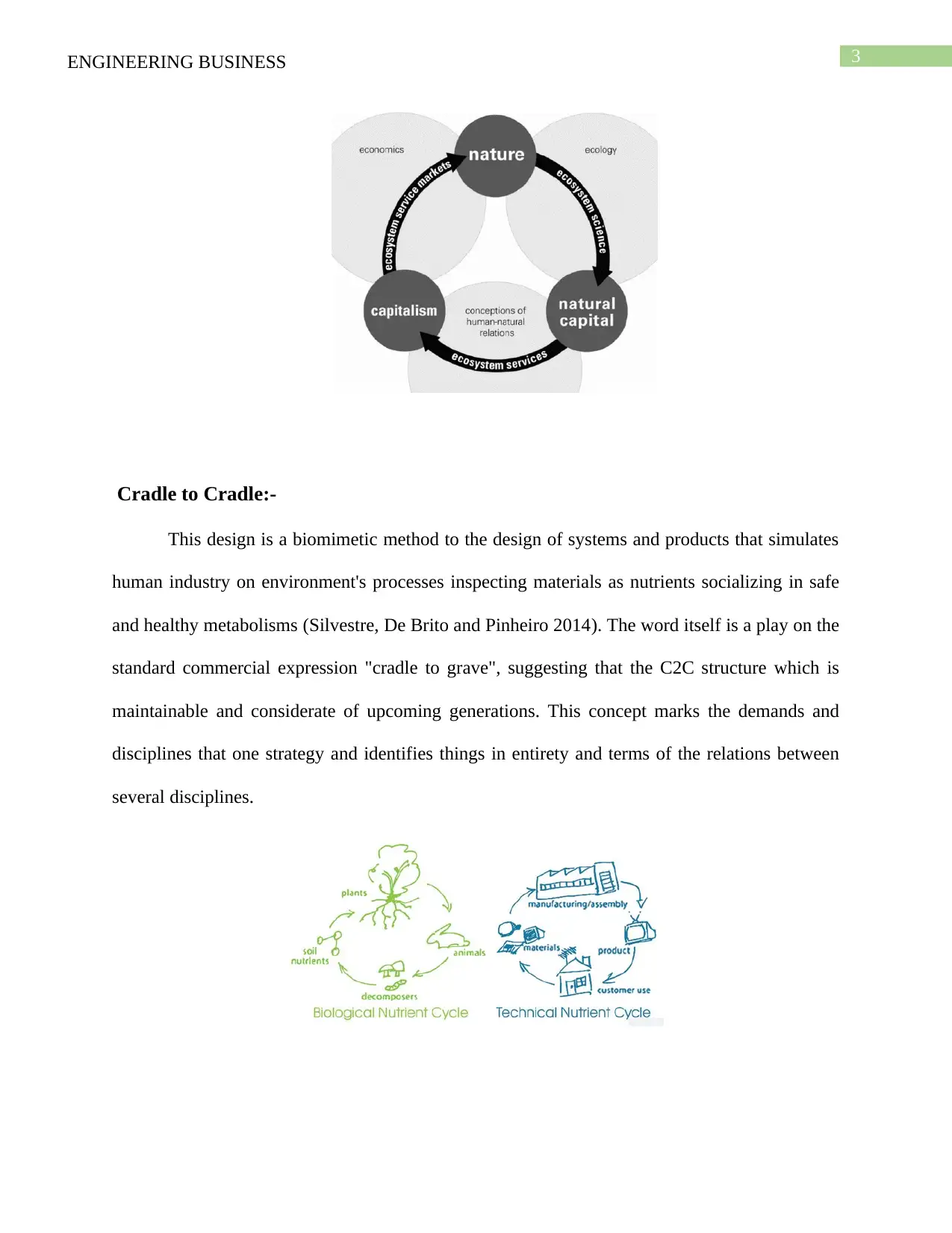
3ENGINEERING BUSINESS
Cradle to Cradle:-
This design is a biomimetic method to the design of systems and products that simulates
human industry on environment's processes inspecting materials as nutrients socializing in safe
and healthy metabolisms (Silvestre, De Brito and Pinheiro 2014). The word itself is a play on the
standard commercial expression "cradle to grave", suggesting that the C2C structure which is
maintainable and considerate of upcoming generations. This concept marks the demands and
disciplines that one strategy and identifies things in entirety and terms of the relations between
several disciplines.
Cradle to Cradle:-
This design is a biomimetic method to the design of systems and products that simulates
human industry on environment's processes inspecting materials as nutrients socializing in safe
and healthy metabolisms (Silvestre, De Brito and Pinheiro 2014). The word itself is a play on the
standard commercial expression "cradle to grave", suggesting that the C2C structure which is
maintainable and considerate of upcoming generations. This concept marks the demands and
disciplines that one strategy and identifies things in entirety and terms of the relations between
several disciplines.
Paraphrase This Document
Need a fresh take? Get an instant paraphrase of this document with our AI Paraphraser
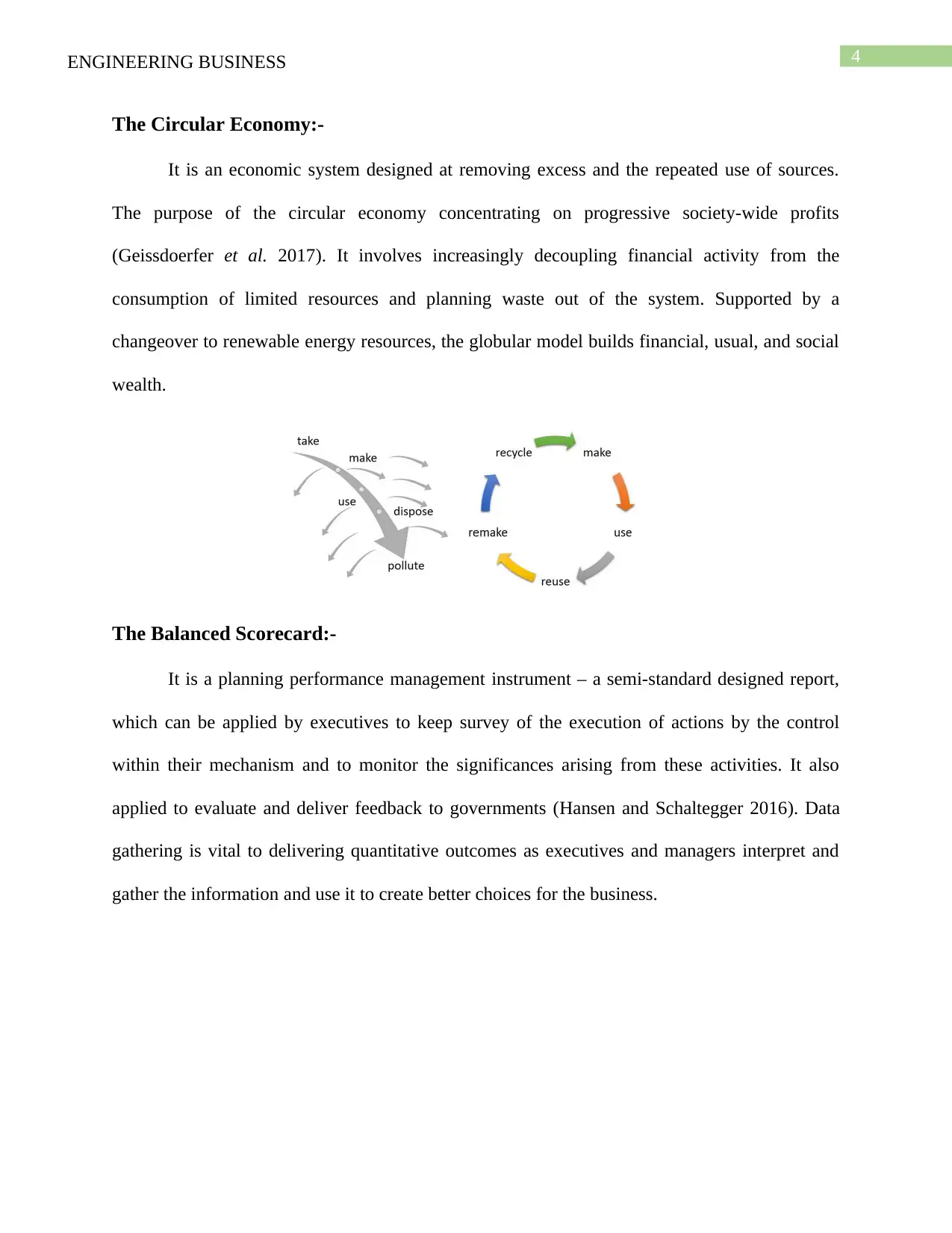
4ENGINEERING BUSINESS
The Circular Economy:-
It is an economic system designed at removing excess and the repeated use of sources.
The purpose of the circular economy concentrating on progressive society-wide profits
(Geissdoerfer et al. 2017). It involves increasingly decoupling financial activity from the
consumption of limited resources and planning waste out of the system. Supported by a
changeover to renewable energy resources, the globular model builds financial, usual, and social
wealth.
The Balanced Scorecard:-
It is a planning performance management instrument – a semi-standard designed report,
which can be applied by executives to keep survey of the execution of actions by the control
within their mechanism and to monitor the significances arising from these activities. It also
applied to evaluate and deliver feedback to governments (Hansen and Schaltegger 2016). Data
gathering is vital to delivering quantitative outcomes as executives and managers interpret and
gather the information and use it to create better choices for the business.
The Circular Economy:-
It is an economic system designed at removing excess and the repeated use of sources.
The purpose of the circular economy concentrating on progressive society-wide profits
(Geissdoerfer et al. 2017). It involves increasingly decoupling financial activity from the
consumption of limited resources and planning waste out of the system. Supported by a
changeover to renewable energy resources, the globular model builds financial, usual, and social
wealth.
The Balanced Scorecard:-
It is a planning performance management instrument – a semi-standard designed report,
which can be applied by executives to keep survey of the execution of actions by the control
within their mechanism and to monitor the significances arising from these activities. It also
applied to evaluate and deliver feedback to governments (Hansen and Schaltegger 2016). Data
gathering is vital to delivering quantitative outcomes as executives and managers interpret and
gather the information and use it to create better choices for the business.

5ENGINEERING BUSINESS
Business type:-
Nestlé is one of the most significant health, nutrition and Wellness Company in the
world. In this report describes the triple bottom line and balance scorecard of nestle.
Triple bottom line:-
The triple bottom line is strong stands in three viewpoints like people, profit and planet.
People:-
Nestle is a very social business which maintains about people. This organization is
dedicating to making the long-term charge. Not only for its stakeholders but also for all those
societies around the universe where market its products. This organization is concentrated on
three aspects which are, transfer of technology, Long-term venture and agricultural training
(Nestlé, 2020). Till now, there are more in 15 industries constructed in the UK and makes about
6500 job chances for local persons. From this instance proves that Nestle donates so much for
the expansion of the local economy.
Profit:-
Business type:-
Nestlé is one of the most significant health, nutrition and Wellness Company in the
world. In this report describes the triple bottom line and balance scorecard of nestle.
Triple bottom line:-
The triple bottom line is strong stands in three viewpoints like people, profit and planet.
People:-
Nestle is a very social business which maintains about people. This organization is
dedicating to making the long-term charge. Not only for its stakeholders but also for all those
societies around the universe where market its products. This organization is concentrated on
three aspects which are, transfer of technology, Long-term venture and agricultural training
(Nestlé, 2020). Till now, there are more in 15 industries constructed in the UK and makes about
6500 job chances for local persons. From this instance proves that Nestle donates so much for
the expansion of the local economy.
Profit:-
⊘ This is a preview!⊘
Do you want full access?
Subscribe today to unlock all pages.

Trusted by 1+ million students worldwide

6ENGINEERING BUSINESS
The UTOP margin of Nestle touched 16.98 %, up 48.63 basis points. The TOP border
enlarged by 29.36 basis points to 14.91%, replicating more significant restructuring-related
outlays. Earnings per share enlarged by 47.45% to CHF 4.07 on a reported basis (Nestlé, 2020).
Original earnings per share enlarged by 14.04% in constant exchange and by 14.05% on a
reported base to CHF 3.92. Nestlé will discover strategic possibilities for meat-based products.
Which helps the business as an additional step in locating the portfolio near attractive high-
growth groupings.
Planet:-
This organization take care of the atmosphere and societies where they operate. The
making of breakfast cereals needs negligible water. Water is applied to cook the wheat and to
wash their apparatus. All these services have an ecological plan against which they extend their
actions and identify techniques to progress the environmental presentation (Nestlé, 2020). This
organization also monitor their energy ingesting in detail and repeatedly work to decrease its use
by presenting energy-effective technologies and movements. The packaging materials of nestle
are the plastic liners, insubstantial boxes and outer cardboard delivery cases. Each material can
all be recycled where services exist. This organization actively inspire clients to reprocess
packaging.
The Balanced Scorecard:-
The Internal Business of nestle contains all Employees and Factories in the UK and all
over the world. Firstly, the monetary standpoint can support the company to recognize its
shareholders’ discernment. Nestlé’s EBIT developed progressively in the past ten year period
from CHF 13652 million to CHF 14694m in the year 2015, a growth of 23.7% (Nestlé, 2020).
Secondly, an inside analysis creates it probable to identify the level of working events of Nestlé.
The UTOP margin of Nestle touched 16.98 %, up 48.63 basis points. The TOP border
enlarged by 29.36 basis points to 14.91%, replicating more significant restructuring-related
outlays. Earnings per share enlarged by 47.45% to CHF 4.07 on a reported basis (Nestlé, 2020).
Original earnings per share enlarged by 14.04% in constant exchange and by 14.05% on a
reported base to CHF 3.92. Nestlé will discover strategic possibilities for meat-based products.
Which helps the business as an additional step in locating the portfolio near attractive high-
growth groupings.
Planet:-
This organization take care of the atmosphere and societies where they operate. The
making of breakfast cereals needs negligible water. Water is applied to cook the wheat and to
wash their apparatus. All these services have an ecological plan against which they extend their
actions and identify techniques to progress the environmental presentation (Nestlé, 2020). This
organization also monitor their energy ingesting in detail and repeatedly work to decrease its use
by presenting energy-effective technologies and movements. The packaging materials of nestle
are the plastic liners, insubstantial boxes and outer cardboard delivery cases. Each material can
all be recycled where services exist. This organization actively inspire clients to reprocess
packaging.
The Balanced Scorecard:-
The Internal Business of nestle contains all Employees and Factories in the UK and all
over the world. Firstly, the monetary standpoint can support the company to recognize its
shareholders’ discernment. Nestlé’s EBIT developed progressively in the past ten year period
from CHF 13652 million to CHF 14694m in the year 2015, a growth of 23.7% (Nestlé, 2020).
Secondly, an inside analysis creates it probable to identify the level of working events of Nestlé.
Paraphrase This Document
Need a fresh take? Get an instant paraphrase of this document with our AI Paraphraser

7ENGINEERING BUSINESS
The third viewpoint of Knowledge & Innovation, Nestlé looks to have a strong focus during the
years. Taking into thought Nestlé’s product invention, it can be seen that the business is directing
for a deeper scope inside this area. Nestlé has realized CHF 1.2 billion in 2018, which has further
improved its proficiencies to a CHF 2.5 billion saving in 2019 (Nestlé, 2020). The examination
of such pointers displays that Nestlé has been capable of increasing its performance over the last
ten years. Despite the crisis activated in 2018, Nestlé is permanently stable on a monetary and
non-financial measure. It appears that the long term approach makes positive outcomes for the
small-term as well.
References:-
Coulson, A.B., Adams, C., Nugent, M.M.N., Hayes, K., Coulson, A.B., Adams, C.A., Nugent,
M.N. and Haynes, K., 2015. Exploring metaphors of capitals and the framing of multiple
capitals. Sustainability Accounting, Management and Policy Journal.
Geissdoerfer, M., Savaget, P., Bocken, N.M. and Hultink, E.J., 2017. The Circular Economy–A
new sustainability paradigm?. Journal of cleaner production, 143, pp.757-768.
Hansen, E.G. and Schaltegger, S., 2016. The sustainability balanced scorecard: A systematic
review of architectures. Journal of Business Ethics, 133(2), pp.193-221.
The third viewpoint of Knowledge & Innovation, Nestlé looks to have a strong focus during the
years. Taking into thought Nestlé’s product invention, it can be seen that the business is directing
for a deeper scope inside this area. Nestlé has realized CHF 1.2 billion in 2018, which has further
improved its proficiencies to a CHF 2.5 billion saving in 2019 (Nestlé, 2020). The examination
of such pointers displays that Nestlé has been capable of increasing its performance over the last
ten years. Despite the crisis activated in 2018, Nestlé is permanently stable on a monetary and
non-financial measure. It appears that the long term approach makes positive outcomes for the
small-term as well.
References:-
Coulson, A.B., Adams, C., Nugent, M.M.N., Hayes, K., Coulson, A.B., Adams, C.A., Nugent,
M.N. and Haynes, K., 2015. Exploring metaphors of capitals and the framing of multiple
capitals. Sustainability Accounting, Management and Policy Journal.
Geissdoerfer, M., Savaget, P., Bocken, N.M. and Hultink, E.J., 2017. The Circular Economy–A
new sustainability paradigm?. Journal of cleaner production, 143, pp.757-768.
Hansen, E.G. and Schaltegger, S., 2016. The sustainability balanced scorecard: A systematic
review of architectures. Journal of Business Ethics, 133(2), pp.193-221.
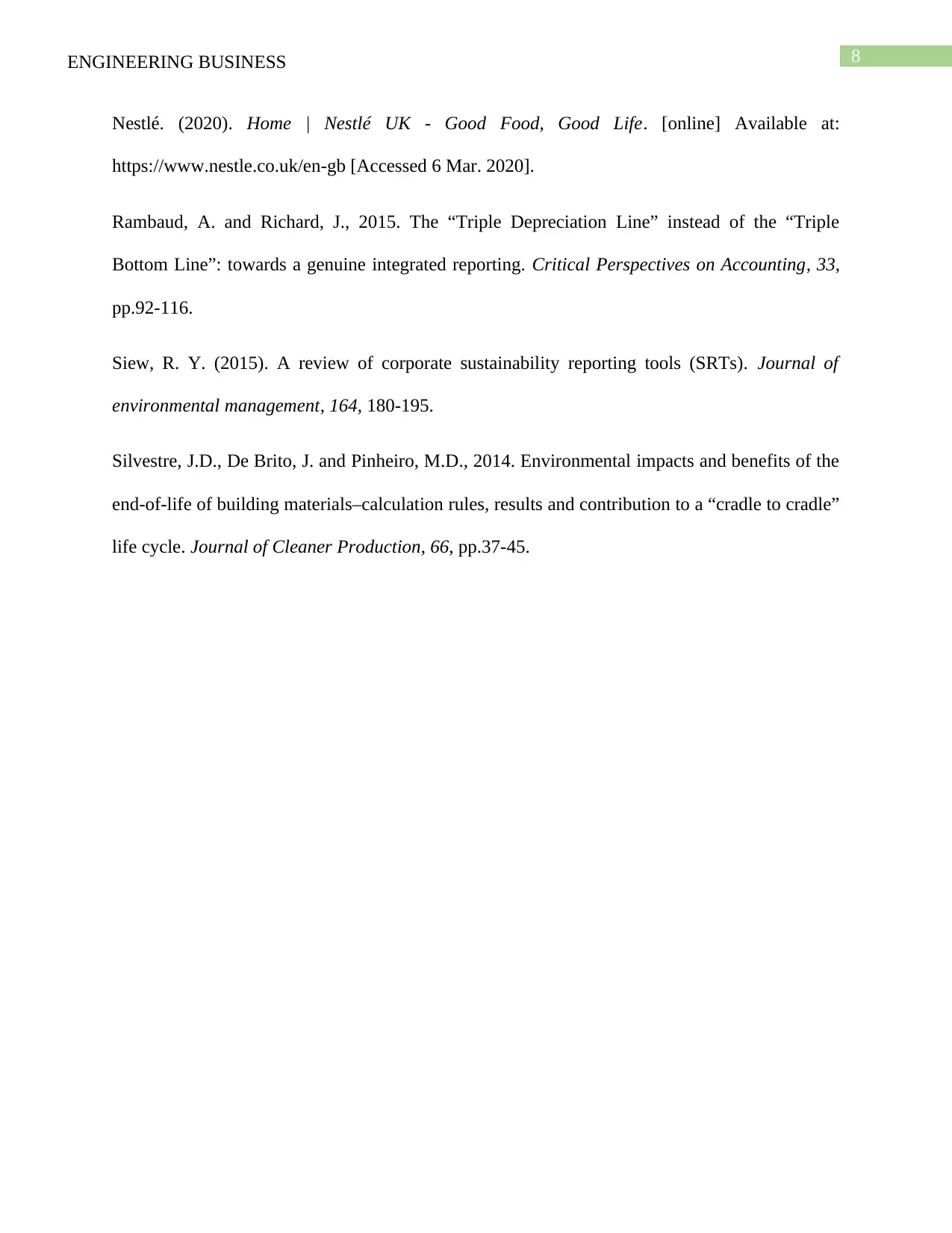
8ENGINEERING BUSINESS
Nestlé. (2020). Home | Nestlé UK - Good Food, Good Life. [online] Available at:
https://www.nestle.co.uk/en-gb [Accessed 6 Mar. 2020].
Rambaud, A. and Richard, J., 2015. The “Triple Depreciation Line” instead of the “Triple
Bottom Line”: towards a genuine integrated reporting. Critical Perspectives on Accounting, 33,
pp.92-116.
Siew, R. Y. (2015). A review of corporate sustainability reporting tools (SRTs). Journal of
environmental management, 164, 180-195.
Silvestre, J.D., De Brito, J. and Pinheiro, M.D., 2014. Environmental impacts and benefits of the
end-of-life of building materials–calculation rules, results and contribution to a “cradle to cradle”
life cycle. Journal of Cleaner Production, 66, pp.37-45.
Nestlé. (2020). Home | Nestlé UK - Good Food, Good Life. [online] Available at:
https://www.nestle.co.uk/en-gb [Accessed 6 Mar. 2020].
Rambaud, A. and Richard, J., 2015. The “Triple Depreciation Line” instead of the “Triple
Bottom Line”: towards a genuine integrated reporting. Critical Perspectives on Accounting, 33,
pp.92-116.
Siew, R. Y. (2015). A review of corporate sustainability reporting tools (SRTs). Journal of
environmental management, 164, 180-195.
Silvestre, J.D., De Brito, J. and Pinheiro, M.D., 2014. Environmental impacts and benefits of the
end-of-life of building materials–calculation rules, results and contribution to a “cradle to cradle”
life cycle. Journal of Cleaner Production, 66, pp.37-45.
⊘ This is a preview!⊘
Do you want full access?
Subscribe today to unlock all pages.

Trusted by 1+ million students worldwide
1 out of 9
Related Documents
Your All-in-One AI-Powered Toolkit for Academic Success.
+13062052269
info@desklib.com
Available 24*7 on WhatsApp / Email
![[object Object]](/_next/static/media/star-bottom.7253800d.svg)
Unlock your academic potential
Copyright © 2020–2025 A2Z Services. All Rights Reserved. Developed and managed by ZUCOL.




